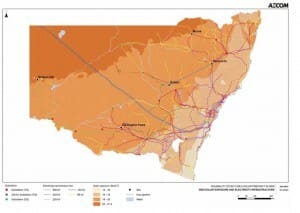The New South Wales government is undertaking a project to explore avenues to strategically encourage the uptake of sources of renewable energy in order to meet the state’s 2020 deadline of 20% energy sourced from renewables under its Renewable Energy Plan. One such project is its Renewable Energy Precincts project, which has established 6 zones covering 47 local government areas under the previous NSW Labour government.
Investigating renewable energy options regionally in NSW
Under the Precincts program, run by the Office of Environment and Climate Change, a Renewable Energy Coordinator has been employed for 3 years (to June 2012) for each of the 6 regions. Coordinators’ roles include engaging with the local communities, facilitating stakeholder engagement, and helping to drive regional initiatives whose purpose is to ‘enhance knowledge, understanding, and uptake’ of renewable energy sources. In general, the projects under investigation are commercial-scale projects as opposed to small-scale, residential ones.
Through the Precincts project, the government has been compiling a database that will help inform future policy directions for renewable energy as appropriate to each region. To date, the initiative has delivered a number of documents and tools relating to the potential for wind power deployment throughout regional NSW, a snapshot report on clean energy jobs in the state, and a pre-feasibility study for a Solar Power Precinct.
What is a solar precinct?
As Australia’s Solar Energy Brokers, Solar Choice’s interest in the Precincts initiative is of course the solar side, however. Features of a Solar Precinct as described in the pre-feasibility report are location of solar plants in the same precinct, shared infrastructure (particularly the electricity grid), and up to 1,000 megawatts (MW) of generation capacity. Plants may utilise solar photovoltaic (PV), solar thermal, or solar-gas hybrid technologies. Some of the areas identified in the study as having good potential for becoming Solar Precincts were Broken Hill, Darlington Point, Dubbo, Moree, and Tamworth. The factors taken into account in making these selections were the amount of sunshine, access to electricity grid transmission infrastructure, access to water, access to gas, and land prices available in each area. (Solar Choice has facilitated a number of medium-scale solar PV projects in the region outside Tamworth, as detailed in a recent article: Solar Farms in New South Wales).

The idea of the establishment of Solar Precincts is an exciting one, taking the concept of a solar farm to a more sophisticated level. The state’s now defunct Solar Bonus Feed-in Tariff Scheme did a good job of encouraging the rapid uptake of solar PV systems on an individual level by financially incentivising installation on the individual level. The Precincts project would set up a more strategic, localised, and economically sustainable model in support of solar. Instead of one solar farm set up for private gain, a well-coordinated government effort would ideally be able to put together a more comprehensive strategy that takes better advantage of potential synergies of co-located solar generation plants, resulting in benefits to the electricity grid, the local community, and the environment.
© 2011 Solar Choice Pty Ltd
Solar Choice Commercial manages the tender process for a wide diversity of large-scale solar power projects throughout Australia, including for solar communities, mining companies, restaurant groups, shopping centres, and rural solar farms. For professional management and consultancy on your solar energy project, contact our Commercial Tender Management team on 1300 78 72 73 for more information.
- Solar Power Wagga Wagga, NSW – Compare outputs, returns and installers - 13 March, 2025
- Monocrystalline vs Polycrystalline Solar Panels: Busting Myths - 11 November, 2024
- Solar Hot Water System: Everything You Need to Know - 27 February, 2024